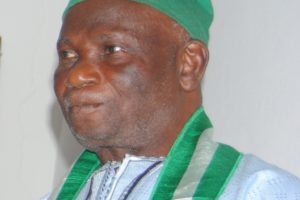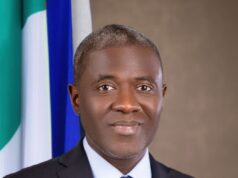
Seventy nine year old Michael Taiwo Akinkunmi who designed the Nigeria’s Green-White-Green national flag in 1959 as the country prepared for Independent in 1960 is now on monthly salary of N800,000, courtesy of the former President, Dr. Goodluck Jonathan.
Ex President Jonathan invited him to Abuja in 2014 and gave him a national award, as well as placing him on a lifetime salary of a presidential special assistant of around N800,000.
He won the sum of 100 pounds ($281 in 1959) as well as a place in Nigeria’s history books when his designed national flag was chosen as official flag for an Independent Nigeria.
Akinkunmi is now a retired civil servant who resides in one of the poorer areas of Ibadan, in a green and white house that can only be reached on foot. Separated from his wife for about two decades, his only live-in companion is his 28-year-old son.
He does not have a phone and last owned a car in the early 1990s. But he enjoys walking through the neighbourhood and further afield to visit two friends from his school days. These excursions add colour to his days. The furthest he recently travelled was a visit to Abuja in
Akinkunmi gives the wrong name for the college he attended in London, doesn’t remember why he underwent surgery within days of winning the competition and cannot give a single detail about what he was doing on October 1, 1960, when Nigeria raised its national flag for the first time.
“Well, I was just pleased,” he says about his feelings on that day. Sunday Olawale Olaniran was an undergraduate at the University of Ibadan when he got to know Akinkunmi , or, as he later dubbed him, the “hero without honour.
“When I met him in 2006, he would never say anything negative,” Olaniran remembers. “He would say ‘God bless Nigeria,’ or ‘Nigeria is moving forward and will keep moving forward.’ Even when you could see around him that he was not well taken care of.”
At the time, Olaniran was compiling a pamphlet on Nigeria’s history. It was during his research for that history that he learned who the designer of the Nigerian flag was and decided to track him down.
“People said he was dead, that I should forget about looking for him and just write about the flag,” he says. But Olaniran kept searching until he found him in Ibadan.
Akinkunmi was living alone, left to the care of his neighbours. On the first day they met, Olaniran says the older man was incoherent and kept talking to himself. His state drove Olaniran to tears.
“So I got in touch with a journalist and we went back two days before Independence Day,” he says.
“Even the journalist couldn’t believe the man was still alive.” The resulting story was published in a newspaper on October 1, 2006, and Olaniran says it was only after it appeared that most Nigerians became aware of Akinkunmi ‘s condition.
Akinkunmi was a pensioner when Olaniran found him, but his pension payments were so irregular that he could not even depend on them to feed himself. “Some Nigerians went to him and donated foodstuff, clothes,” Olaniran says.
Then, in 2008, Olaniran was contacted through his blog by a representative of the Nigerian edition of Who Wants to be a Millionaire, asking to be put in touch with Akinkunmi .
For his appearance on a special edition of the TV show, Akinkunmi was given a cheque for two million naira (around $10,000). This was the money his son says was used to complete the green and white building they now live in.
Following that second bout of nationwide publicity, Olaniran and other supporters began writing to the Nigerian government about Akinkunmi.
The then minister of information, Dora Akunyili, came to hear of it, and went to Ibadan to meet him.
“I think it was because of her that he was selected for the 50 distinguished Nigerians honour,” Olaniran says. During Nigeria’s golden jubilee celebrations in October 2010, Akinkunmi received a presidential award for being a distinguished Nigerian, the first time the federal government had publicly honoured him.
Four years after he first discovered Akinkunmi ‘s role in Nigerian history, Olaniran’s cause celebre had finally caught the attention of the country’s leaders. Akinkunmi doesn’t remember much about the official ceremonies in his honour, but he does recall how he returned from the UK with his degree in 1964, and 29 years later, left government service.
In 1993, he was advised by his superiors to go into early retirement because of illness. His son does not know what the illness was, and Akinkunmi cannot remember what the doctors diagnosed.
The only symptoms he can describe are a relapsing fever and “thinking too much.” He has been on medication for many years, but three months ago the doctors took him off the pills whose names he cannot remember.
One memory that has not forsaken him, however, is the admiration and support he received from ordinary Nigerians upon coming back to the country after the Union Jack had been replaced by his green-white-green flag.
“I was well-known all over the place. Everybody was calling me Mr Flag Man.”
Source: Aljazeera. [myad]








